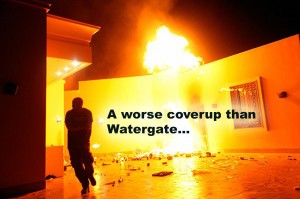 What we know about the attack in Benghazi one year after the fact is that it is an example of the Obama administration’s incompetence and mendacity. More worrisome still is what we don’t know.
What we know about the attack in Benghazi one year after the fact is that it is an example of the Obama administration’s incompetence and mendacity. More worrisome still is what we don’t know.
We do not know how or why the State Department would send Ambassador Chris Stevens and his team to work at a facility with almost comically insufficient security, in a city that was growing more dangerous by the week — in Libya, dangerous territory for Americans at the best of times.
Shortly after the attack, Hillary Clinton called for an internal Accountability Review Board to examine the decisions surrounding security in Benghazi. The ARB report faulted four midlevel officials, conspicuously absolving of all responsibility the secretary herself and her closest advisers. Whether Secretary Clinton’s thinking on the events was unclear or mistaken at the time, we do not know, since the so-called accountability panel unaccountably did not even bother to interview her.
The four found to be at fault were placed on paid administrative leave, but Secretary of State John Kerry returned them to regular duty in August; they will not face any formal disciplinary action, which is to say they were punished with extra vacation time.
Secretary Clinton may not have wanted to speak to the accountability panel; strangely, it also refused to interview those who did desire to share their testimony. The State Department inspector general’s office announced in May that it would investigate why the review board had “failed to interview key witnesses who had asked to provide their accounts of the Benghazi attacks to the panel.” The decision to willfully ignore State Department employees who were volunteering information about the murder of an American ambassador suggests that the board began with a conclusion and avoided any possible contact with evidence that might contradict that conclusion.
Then there is the great mystery about why Stevens and his team were in that dangerous city to begin with. We know Washington was deeply concerned about dangerous Islamists obtaining “stinger” surface-to-air missiles that were smuggled into Libya during the civil war by Qatar — with the secret blessing of the Obama administration. On August 1, CNN reported that “dozens” — as many as 35 — CIA personnel were in Benghazi the night of the attack and that seven were injured, a figure out of line with any previous government explanation of those bloody events.
There also remain the troubling questions about whether anything could have been done to save Stevens and his team that night. While testifying before Congress, Stevens’s deputy, Greg Hicks, said a security team at the U.S. Embassy in Tripoli had been ordered to “stand down” — that is, ordered not to go to Benghazi to rescue U.S. personnel. Hicks described security-team leader Army Lt. Col. S. E. Gibson’s frustration over that order. In June, the House Armed Services Committee issued a terse statement insisting that Gibson was “not ordered to ‘stand down’ by higher command authorities” — with no explanation of why Hicks had testified otherwise. A CBS News report in October 2012 said that a Germany-based Commander’s In Extremis force was moved to Italy that night, but State Department “concerns about violating Libyan sovereignty made a military rescue mission impractical.” If a military rescue was attempted, it is critical to know why it was aborted — and by whom.
Finally, there is the issue of the laughably false explanation initially given to the American public surrounding the attack. White House press secretary Jay Carney has already been caught offering the bald-faced lie that the only changes to the “talking points” attributing the Benghazi attack to a protest over a YouTube video were “stylistic edits.” No one on the ground in Benghazi reported a protest, leaving no clear explanation of how it became the centerpiece of the administration’s storyline on the attacks. Unless, of course, the administration invented that explanation out of whole cloth.
The demonization of a nobody uploading videos onto YouTube, and his subsequent arrest on a parole violation, suggest a chilling cynicism at the highest levels of the Obama administration. In what may very well have been the most shameful moment in a career full of them, Hillary Clinton assured Charles Woods, the father of the slain former Navy SEAL, at a memorial service, “We will make sure the person who made that film is arrested and prosecuted.” Obama continued to cite the video while discussing the Benghazi attacks on The Late Show with David Letterman and at a forum on Univision. Either he knew full well that his account was malicious fiction or his administration has been culpably negligent in its handling of sensitive intelligence.
After the attacks, the president made his usual rote pledges to ensure that justice is done. Today, one year later, no one has been arrested, jailed, or executed for his role in the murder of four Americans. Special operators in the region told Fox News in August that while Benghazi-related targets have been identified for months, officials in Washington could “never pull the trigger.”
For its stunning blend of recklessness, fecklessness, callousness, and shamelessness, Benghazi overcomes steep competition to remain the worst of the Obama administration’s collection of scandals. The American people deserve to know what happened and why.
. . . . . . . . . . . . . . . . . . . .
This op-ed article was written by the editorial board of the National Review.